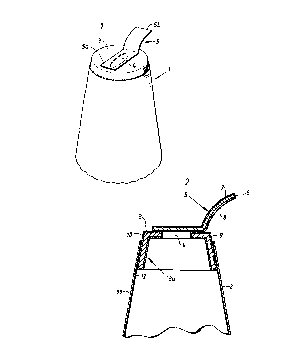Une partie des informations de ce site Web a été fournie par des sources externes. Le gouvernement du Canada n'assume aucune responsabilité concernant la précision, l'actualité ou la fiabilité des informations fournies par les sources externes. Les utilisateurs qui désirent employer cette information devraient consulter directement la source des informations. Le contenu fourni par les sources externes n'est pas assujetti aux exigences sur les langues officielles, la protection des renseignements personnels et l'accessibilité.
L'apparition de différences dans le texte et l'image des Revendications et de l'Abrégé dépend du moment auquel le document est publié. Les textes des Revendications et de l'Abrégé sont affichés :
| (12) Brevet: | (11) CA 2011319 |
|---|---|
| (54) Titre français: | CONTENANT D'EMBALLAGE POUR LIQUIDE, SURTOUT SOUS PRESSION |
| (54) Titre anglais: | PACKING CONTAINER FOR LIQUID, ESPECIALLY PRESSURIZED CONTENTS |
| Statut: | Périmé et au-delà du délai pour l’annulation |
| (51) Classification internationale des brevets (CIB): |
|
|---|---|
| (72) Inventeurs : |
|
| (73) Titulaires : |
|
| (71) Demandeurs : |
|
| (74) Agent: | MARKS & CLERK |
| (74) Co-agent: | |
| (45) Délivré: | 1998-09-15 |
| (22) Date de dépôt: | 1990-03-02 |
| (41) Mise à la disponibilité du public: | 1990-09-29 |
| Requête d'examen: | 1992-05-19 |
| Licence disponible: | S.O. |
| Cédé au domaine public: | S.O. |
| (25) Langue des documents déposés: | Anglais |
| Traité de coopération en matière de brevets (PCT): | Non |
|---|
| (30) Données de priorité de la demande: | ||||||
|---|---|---|---|---|---|---|
|
Récipient d'emballage comportant une paroi d'extrémité (3) et une ouverture de vidage (4) incorporée dans la paroi d'extrémité, laquelle est recouverte d'une bande de fermeture (5) appliquée de façon détachable à l'extérieur de la paroi d'extrémité. La bande de fermeture (5) et la paroi d'extrémité (3) sont faites de métal recouvert de plastique et sont rattachées l'une à l'autre le long d'un joint de scellement formé par fusion superficielle sur tout le pourtour de l'ouverture de vidage.
A packing container comprising an end wall (3) and an
emptying opening (4) incorporated in the end wall which is
covered by means of a cover strip (5) applied detachably to
the outside of the end wall. The cover strip (5) as well
as the end wall (3) consist of a plastic-coated metallic
material and are attached to one another along a sealing
joint formed by surface fusion around the whole emptying
opening .
Note : Les revendications sont présentées dans la langue officielle dans laquelle elles ont été soumises.
Note : Les descriptions sont présentées dans la langue officielle dans laquelle elles ont été soumises.

2024-08-01 : Dans le cadre de la transition vers les Brevets de nouvelle génération (BNG), la base de données sur les brevets canadiens (BDBC) contient désormais un Historique d'événement plus détaillé, qui reproduit le Journal des événements de notre nouvelle solution interne.
Veuillez noter que les événements débutant par « Inactive : » se réfèrent à des événements qui ne sont plus utilisés dans notre nouvelle solution interne.
Pour une meilleure compréhension de l'état de la demande ou brevet qui figure sur cette page, la rubrique Mise en garde , et les descriptions de Brevet , Historique d'événement , Taxes périodiques et Historique des paiements devraient être consultées.
| Description | Date |
|---|---|
| Inactive : CIB de MCD | 2006-03-11 |
| Le délai pour l'annulation est expiré | 2004-03-02 |
| Lettre envoyée | 2003-03-03 |
| Accordé par délivrance | 1998-09-15 |
| Inactive : Taxe finale reçue | 1998-04-09 |
| Préoctroi | 1998-04-09 |
| Inactive : Pages reçues à l'acceptation | 1998-04-09 |
| Un avis d'acceptation est envoyé | 1997-10-22 |
| Un avis d'acceptation est envoyé | 1997-10-22 |
| Lettre envoyée | 1997-10-22 |
| Inactive : Renseign. sur l'état - Complets dès date d'ent. journ. | 1997-10-15 |
| Inactive : Dem. traitée sur TS dès date d'ent. journal | 1997-10-15 |
| Inactive : CIB enlevée | 1997-08-27 |
| Inactive : CIB en 1re position | 1997-08-27 |
| Inactive : CIB attribuée | 1997-08-27 |
| Inactive : Approuvée aux fins d'acceptation (AFA) | 1997-08-13 |
| Exigences pour une requête d'examen - jugée conforme | 1992-05-19 |
| Toutes les exigences pour l'examen - jugée conforme | 1992-05-19 |
| Demande publiée (accessible au public) | 1990-09-29 |
Il n'y a pas d'historique d'abandonnement
Le dernier paiement a été reçu le 1998-02-17
Avis : Si le paiement en totalité n'a pas été reçu au plus tard à la date indiquée, une taxe supplémentaire peut être imposée, soit une des taxes suivantes :
Veuillez vous référer à la page web des taxes sur les brevets de l'OPIC pour voir tous les montants actuels des taxes.
| Type de taxes | Anniversaire | Échéance | Date payée |
|---|---|---|---|
| TM (demande, 8e anniv.) - générale | 08 | 1998-03-02 | 1998-02-17 |
| Taxe finale - générale | 1998-04-09 | ||
| TM (brevet, 9e anniv.) - générale | 1999-03-02 | 1999-02-19 | |
| TM (brevet, 10e anniv.) - générale | 2000-03-02 | 2000-02-18 | |
| TM (brevet, 11e anniv.) - générale | 2001-03-02 | 2001-02-20 | |
| TM (brevet, 12e anniv.) - générale | 2002-03-04 | 2002-02-21 |
Les titulaires actuels et antérieures au dossier sont affichés en ordre alphabétique.
| Titulaires actuels au dossier |
|---|
| TETRA LAVAL HOLDINGS & FINANCE S.A. |
| Titulaires antérieures au dossier |
|---|
| BENGT BJORCK |